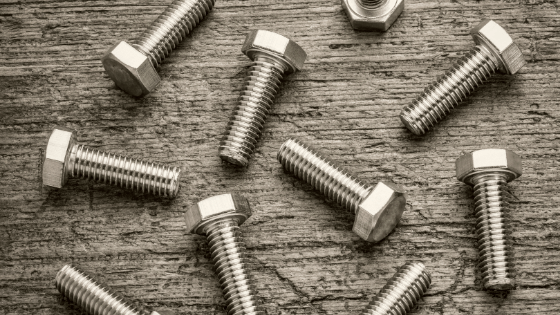
303 and 304 stainless steel are two popular stainless steel grades. Widely recognized for both its strength and its anti-corrosive properties, stainless steel appears in kitchen accessories, surgical tools, auto bodies, and sculptures. Its stainless properties make it not only corrosion resistant but also aesthetically dependable and thus popular. Not all stainless steel is the same, however. Like other forms of steel, stainless steel comes in a variety of grades. So, let’s take a closer look and compare 303 vs 304 stainless steel.
Kloeckner Metals is a full-line stainless steel supplier and service center. Download our stainless steel spec sheet and check what Kloeckner Metals routinely stocks.
Grade 303 stainless steel can be bought in plates, hex bars, round bars, square bars, or rolled flat bars. It is a non-magnetic, austenitic metal that cannot be hardened by heat treatment. Kloeckner Metals routinely stocks T-303 stainless steel bar.
This stainless steel grade resists mildly corrosive elements, but it will pit and rust in a marine environment due to the chloride in the salt. In fact, this steel will crack in chloride environments above 140o F. Grade 303 stainless steel will, however, resist oxidation in environments up to 1700o F.
Chemically, grade 303 stainless steel consists of iron, chromium (17-19%), nickel (8-10%), manganese (2%), phosphorus (0.2%), carbon (0.15%), and sulfur (0.15% minimum). The exact percentages may vary slightly because this grade of steel is categorized by its physical properties rather than its chemical ones.
Steel’s strength is a measure of its ability to withstand force without breaking or permanently deforming.
Yield strength identifies the point at which steel deforms under stress. Metals experts determine yield strength through a series of experiments and express it in megapascals (MPa) or N/m2. Grade 303 stainless steel’s yield strength runs about 415 MPa.
Tensile strength identifies the point at which steel breaks under stress. It is determined by conducting an experiment with a sample and then dividing peak force by cross-sectional area. The tensile strength of grade 303 stainless steel hovers around 690 MPa. This grade of steel will elongate 40% before breaking.
Yes, grade 303 stainless steel can be hardened but not by heat. It has to be solution treated by heating it to about 1850o F to 2048o F and then rapidly cooling it off. As a result, it will lose some of its ductility if hardened.
Due to its relatively high sulfur content, this grade of steel shouldn’t be welded, but it is possible to weld it using alloy 310 electrodes.

Grade 303 stainless steel is easy to machine, though. It can be cut with a sharp, light edge using coolants and lubricants in large amounts. Consequently, this grade is an excellent choice for manufacturing parts that require extensive machining.
Much grade 303 stainless steel winds up as screws, bolts, gears, shafts, valves, aircraft parts, or screw machine products. It is not appropriate for ships, boats, or anything that will be used to transport gas under pressure
Grade 304 stainless steel is probably the most commonly used grade of austenitic stainless steel. (In austenitic steels, the alloy contains high percentages of nickel and chromium.) It is available in 304 stainless steel sheet, 304 stainless steel bar, 304 stainless steel plate, and 304 stainless steel tube.
As a result, austenitic steels are highly corrosion resistant, not only from weather but also from acids. However, these steels have one weakness — chloride. The ions in sodium chloride, such as that found at the coast, will badly pit grade 304 stainless steel.
This grade features a nickel content of 8%—10.5% and a chromium content of 18%—20%. Most grade 304 stainless steel is 18/8, meaning it is composed of 18% chromium and 8% nickel. It also includes carbon, silicon, and manganese.
Grade 304 stainless steel is one of the strongest, most durable, and best quality steel grades available. Its tensile strength falls between 520 and 720 MPa, and its yield strength is about 215 MPa. It will elongate up to 70% before breaking.
Like its counterpart, grade 303, grade 304 stainless steel cannot be hardened by heat treatment. It also has to be solution treated by heating it to about 1850o F to 2048o F.
Unlike grade 303 stainless steel, however, grade 304 is easy to weld. It can even be welded without fillers, but if the welder chooses fillers, they should generally be from grade 308 stainless steel. Sections that are heavily welded may need post-welding solution treatment.
Grade 304 stainless steel features good machinability. Like grade 303, it needs to be cut with a sharp blade, using light cuts with plenty of lubricants and coolants on hand.
Grade 304 stainless steel is tough and economical. It’s easy to fabricate and clean, looks good in nearly any setting, and can withstand significant exposure to corrosive elements. As a result, it is the most commonly used grade of stainless steel on the market.
You can find grade 304 stainless steel in just about any product in which steel is the major element — auto trim, wheel covers, kitchen equipment, piping, stainless hardware, and storage tanks.
These two grades of stainless steel are very similar. They are comparably constructed, and they are both useful, durable, and cost efficient. Nevertheless, they are not the same.
Major differences include:
Trying to determine which grade of steel is best for your project? Contact us to find out the best approach.
Kloeckner Metals is a full-line stainless steel supplier and service center. Kloeckner Metals combines a national footprint with the latest fabrication and processing technologies and most innovative customer service solutions.

Steel base plates are fundamental elements employed in various manufacturing...
Metal fabrication is a critical process that transforms raw metal...
The solar industry has undergone a significant transformation by incorporating...

X
The Kloeckner Metals website uses modern technologies. Unfortunately, your browser doesn't support those technologies.
Download the latest version of one of these browsers to experience the site: